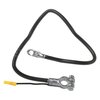Hey Slowmover,
Looks like that is what I was mixed up about. I was reading it as the negative needs to terminate closest to the ground for the battery. This makes more sense. I have a seat bolt right next to the radio. I'll give that a shot. That would cut the circuit down by 10' or so. I should have figured that is what was meant as that is how my amp for the stereo is done. I could even cut out some length on the positive side. I do have a little bit extra tucked under the dash.
When I started driving big trucks it was a rule to severely limit Radio “on” time without the engine running.
It’s popular with some in the Amateur crowd to install an auxiliary battery
to keep all wiring distinct from vehicle system wiring. It’s fairly involved to do it right (and expense is high)
but it really won’t add a great deal of TX time.
On the 2020 Pete I’m in (built 8/19), I’ve four (4) Start batteries
and a powerful diesel genset (plus inverter). With main engine off I can kick on that APU and run air-conditioning, etc.
I have two Volt Meters with which I monitor battery state. The Start batteries will disconnect at a voltage which enables re-start. I “might” kick in the unit for Radio but that happens maybe 2X yearly. (I’ve usually gone to bed within an hour of going Off-Duty).
So, short of a lot of idle time on your engine (not emissions-friendly) here’s a good excuse to get one of those little Honda generators you’ve been wanting. (No need for extra fuel. Keep trunk-lid cracked while underway.
A larger alternator, etc, can be more than it looks like. I’m in favor of it where it’s a straight bolt-in.
Alternator controls are another matter. The whole can can double the price of the alternator, alone.
As an RVer I have a primary incentive for vehicle electrical upgrades. Radio is secondary.
So study Mr Applegate and then try to find someone else who’s modded your same vehicle in like manner.
Create parts list (credit card list). Tools and Supply also figure.
I’ve been happy to do these things, but, hell, I’m a truck driver. Can’t afford women, gambling, guns or fast cars.
Indulge the nerd inside.
Expect that being new (again) to the hobby has both steep learning and wallet-depletion curves.
Mistakes =
“man, I’ve got a really great box of spares!”
.




